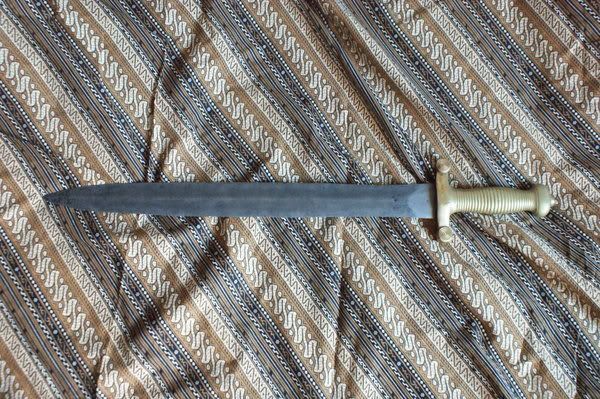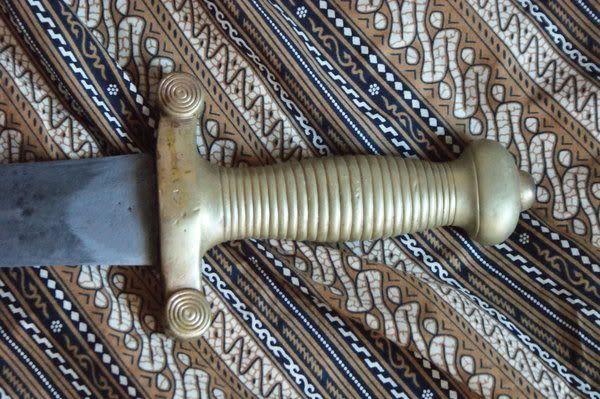
 |
|
|
#1 |
|
Member
Join Date: Jan 2005
Location: Singapore
Posts: 1,248
|
A sword belonging to a friend, for identification.
It had been keep in his family for 90+ years. Before that, unknown.   The sword in question  A close up of the hilt, made from brass, (I think). Help in identifying this piece is much appreciated. 
Last edited by Alam Shah; 9th April 2008 at 12:42 PM. |
|
|

|
|
|
#2 |
|
Member
Join Date: Jul 2005
Location: Toronto, Canada
Posts: 1,242
|
Hi Alam Shah,
This looks like a French 1831 Artillery sword, one of my favourite swords. Known as the "cabbage cutter", I think it makes a good chopper. The model was adopted and modified by the Americans as the 1832 Foot Artillery Sword. There is a British design as well, but I forgot its name. It's odd that this example doesn't have the requisite markings on the guard. There should be one in the middle of the guard block if French, both sides I think. On the last picture there seem to be faint traces of one, possibly ground off? I've been looking for an 1831 at good price for a long time. Can't seem to find any bargains. Regards, Emanuel |
|
|

|
|
|
#3 | |
|
Member
Join Date: Jan 2005
Location: Singapore
Posts: 1,248
|
Quote:
 
|
|
|
|

|
|
|
#4 |
|
Member
Join Date: Oct 2005
Location: Paris (FR*) Cairo (EG)
Posts: 1,142
|
Looks like a French 1831 Army (sorry Manolo) model sword,
in service until 1866 in French army, then used by fire-fighters, national guards until 1870. This sword appear during the reign of "roi des Français" Louis-Philippe 1er, and then in used during the Second Empire, the one of Napoléon III f.y.i. Manolo  copy - new http://www.wkc-solingen.de/newshop/francais/Glaive.html in sale - Réf 10-252 http://www.cedric-rolly-armes.fr/armes-blanches.php in fact, made a search as following "vends glaive modele 1831" à + Dom |
|
|

|
|
|
#5 |
|
Member
Join Date: Jul 2005
Location: Toronto, Canada
Posts: 1,242
|
Glaive d'infanterie serait peut-être plus précis mais "artillery sword" va assez bien en englais
 I'll read up some more on the model but I do believe it was the infantry artillery that got the model, not just any army corps. English site: http://www.arms2armor.com/Swords/fren1831.htm I found a number of replicas as well Dom, but I'd like an old one. The newer ones are hangers, the old were used  Emanuel |
|
|

|
|
|
#6 |
|
Member
Join Date: Oct 2005
Location: Paris (FR*) Cairo (EG)
Posts: 1,142
|
mea culpa, Emanuel is correct
I wasn't control enough my subject  and the facts are ; during Empire, French Artillery was consisted of; - foot artillery - horse artillery the first following on foot the second, who was with canons pulled by horses, between them, uniforms was significantly differents Emanuel .... the second link didn't concern a copy, but an original, I dunno if the price requested is realistic  à + Dom |
|
|

|
|
|
#7 |
|
Arms Historian
Join Date: Dec 2004
Location: Route 66
Posts: 9,943
|
Nice work Emanual and Dom!!!
Its really great to see detailed and informative identification responses like this, and so quickly, on regulation swords which of course are far outside the standard weapons discussed here. I like seeing the range expanded once in a while! Nicely done, and thank you ! All the best, Jim P.S. Emanuel, have you tried LeHussar in France? |
|
|

|
|
|
#8 |
|
Member
Join Date: Jan 2006
Location: Kent
Posts: 2,653
|
Hi Emanuel,
I too having been waiting for a bargain priced example  ....I like the 'classical' shape.....afterall it was 'copied' design from the Roman Gladius. ....I like the 'classical' shape.....afterall it was 'copied' design from the Roman Gladius.However, am I correct in saying that 'cabbage cutter' was a derogatory name ....as the sword is relatively heavy with poor 'balance'. Regards David |
|
|

|
|
|
#9 |
|
Arms Historian
Join Date: Dec 2004
Location: Route 66
Posts: 9,943
|
Hi David,
That term was indeed intended derisively, and while these neoclassic swords lent well to rather pretensious allusion, they were not especially well balanced nor effective. On that note, I recall an instance some time ago concerning the M1832 U.S. artillery sword, when one was unearthed during construction excavation somewhere in New York. While I'm pretty sure the well known pulp newspapers were not involved, a very wide eyed archaeologist proclaimed he had found evidence of Romans in America!!  Soon afterwards the excavated 'gladius' was correctly identified by a better informed observer, much to the chagrin of the proclaimer. Best regards, Jim |
|
|

|
|
|
#10 | |
|
Member
Join Date: Jan 2006
Location: Kent
Posts: 2,653
|
Quote:
Hi Jim  thanks for the clarification. It seems that the 'wide eyed archaeologist' should have 'unearthed' some researched facts before making his claims   All the best David |
|
|
|

|
|
|
#11 |
|
Member
Join Date: Jul 2005
Location: Toronto, Canada
Posts: 1,242
|
Hi All,
Dom you're right about the artillery division - I only considered the foot. The first time I tried the link it wouldn't load, but now it worked. It looks like the frog is a replacement. Here I saw 1831s go for $350 Canadian, quite a bit cheaper than 360EU. Now I wonder what prices are like in France, Germany, etc... on the street in small antique shops. David, when I handled the 1831 it felt like a robust chopper, perhaps akin to a Moro barong. Made for chopping, and chopping well I think. The term was derogatory because the sword had no finesse, one didn't have to be a skilled fencer to use it I imagine. Jim I didn;t know about Le Hussard, thank you for that link. They ahve some 1831s listed at 270EU. Not bad perhaps, but at "bargain" I want less  The cheapest I saw was 250CAD here in To. Should have grabbed it The cheapest I saw was 250CAD here in To. Should have grabbed it  Cheers! Emanuel |
|
|

|
 |
|
|